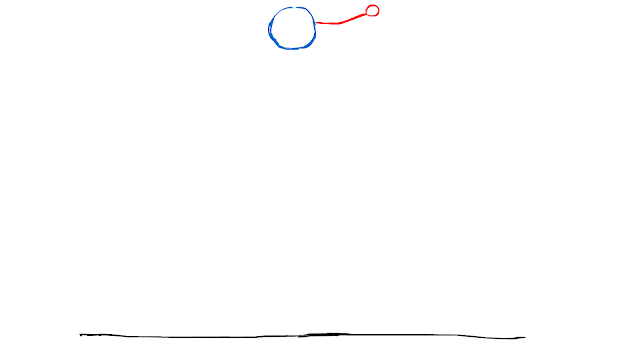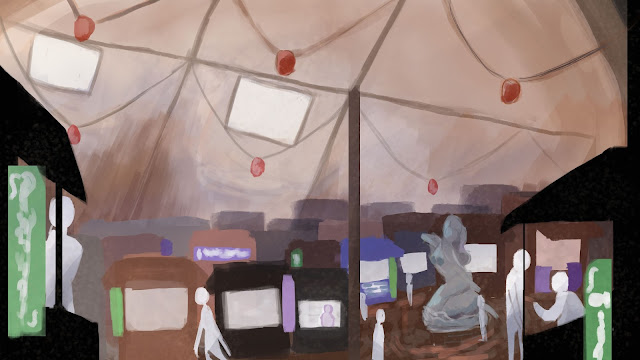2001: A Space Odessey is a science fiction movie, directed by
Stanley Kubrick back in 1968, the film as been, referenced and parodied in loads of other media because of how memorable the events of the film and the premise of it was. The film, to the surprise of a lot of modern day audiences, was all done with Models, Minitures and Matte Painting, not one bit of CGI was featured in this film thats dated before the Moon Landing.
 |
| Fig 1: Film Poster for "2001: A Space Odyssey" |
The film starts of with the prehistoric age, focusing on a pack of gorillas as they survive in the harsh wild until one day a giant ominous black box lands in their habitat. From there the apes learn how to use weapons from bones, clubbing a rivel ape to death before tossing the bone idling into the air. This leads to a jump cut to the space age, with many establishing space shots before landing on a Dr Heywood Floyd, who is planning a trip to Clavius Base, an American establishment settled on the Earth's Moon. According to his soviet colleague, a mysterious outbreak has occured on the base, to which he and a team go there to investigate. Only to find the mysterious structure that occured on Earth a million years prior.
Another jump cut, 18 months later, the spaceship, Discover One is on course for Jupiter, the crew consisting of 4 cryogenic hybernatated men and women, Dr Frank Poole, and Dr David Bowman, as well as the faultless AI computer, The Hal 9000. A status report is issued by HAL about the satalite on the outside of the ship's failure, which would reach 100% by the next day. Frank and Dave head to the EVA pods, but upon reaching the "faulty" equipment, they find that there is nothing wrong with it. Upon asking HAL about the error, he says that it is a human error in his coding and that he is never wrong, going against what the back up of HAL reads to the two doctors read before their inquiry. They then discuss what to do with HAL inside the EVA pod, to prevent the AI from hearing without knowing that he could lip read everything they are saying. Soon after Frank and Dave leave the spaceship in pods to attend to a maintenance issue on the outside of the side ship. Hal sees an opportunity kills Frank and the other hibernated crew members, in order to preserve himself to continue the mission. Upon seeing Franks body flying out in space, Dave uses the other EVA pod to go out and retrieve him. The attempt is futile in the end and Dave has to dump the body of his colleague to get back to the ship that HAL put into tight security to prevent his return, leaving him stranded in the pod, without a helmet. He resorts to the emergency manual exit, succeeds and then progresses to HAL main system. Despite HAL apologizing to Dave for what he's done, making up excuses of how he is sorry for his actions against the crew. However Dave continues onwards to the main controls for HAL and then proceeds to remove the memory boards as the AI protests as he is lobotomized to the point where all he can do is sing "Daisy" until he is disconnected for good. A message from Dr Heywood Floyd then plays, stating the reasons for why the journey to Jupiter was made, thanks to his findings on the moon base, Clavius. The way that HAL acts at that part of the scene all the way up to his death give him, an AI robot, much more depth of character then any of the human cast
"Placing sympathy and humanity onto a machine character instead of the human characters is an effective way of establishing the dehumanising effect of the modern world."-Thomas CaldwellFrom there the movie turns into a massive drug trip, full of colours and lights while stills of Dave's screaming distort face could be seen. After the long segment, Dave arrives, aged and withered from the trip, to a Victorian like room. As he explores the room the viewer jumps to the perspective of Rapidly aging Dave's before it ends with him lying on his death bed staring that the black artifact, before then being reborn into a star baby.
 |
| Fig 2: A Shot from the film showing on Kubrick's One Point Perspetive Filming style |
Thanks to the movie's ambiguous ending then film has many theories about what the symbolism of the final segments mean. If it's about rebirth or something else about the progress of the human species and of how even though we have progressed we are still primitive in our ideology.
"It's puzzling to me that 2001 is a film about the process of transcendence, but one which staunchly refuses to comment on why we as a race would deserve transcendence. In its uniquely closeted, cornered off, undemonstrative and aloof way, this brilliant albeit maddening film manages to jettison subtext in favour of cinematic spectacle." David Jenkins- littlewhitelies.co.uk
Also the way some shots were made, breaking the rule of thirds and making your eyes go to the centre of a symetrical hallway through the use of one point perspective (a favourite shot of Kubrick) which gives a sense of claustrophobia, that the walls on either side are about to come in on you. This sense of tightness, especially with how small the interior of the Discovery One really helps in bringing up the tension between Hal and the crew. The way the film is paced, too, adds to the tension for the majority of cases, sometimes the pacing drags on for too long leaving some viewers to become bored, wanting some action to occur.
"The special effects were mind-blowing back then. It was a trip just to look at the film, never mind think about it. (And I use the word ''trip'' to signal that for all the futuristic mood of the film there is simultaneously an inclusion of contemporary pop cultural style, especially in the final segment when the film becomes plainly psychedelic.)"- Ben Livant- djardine.blogspot


















































